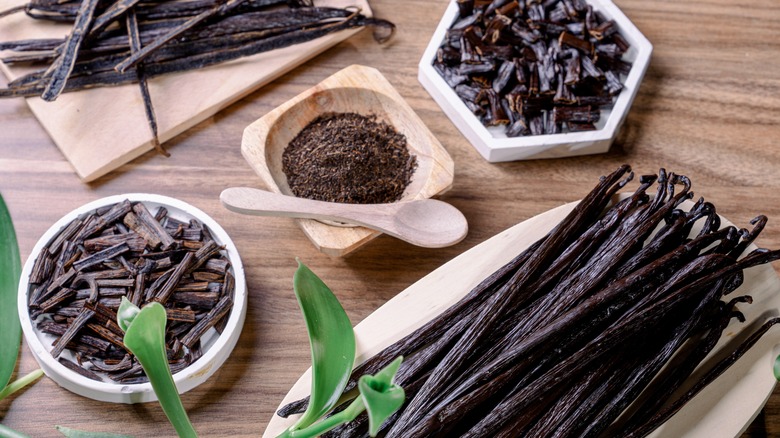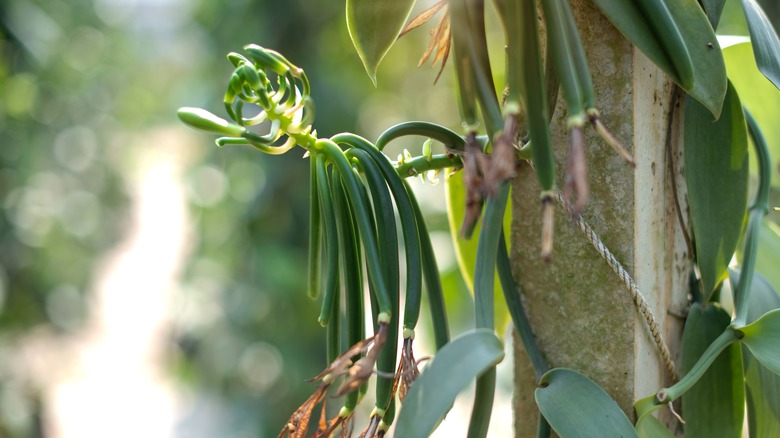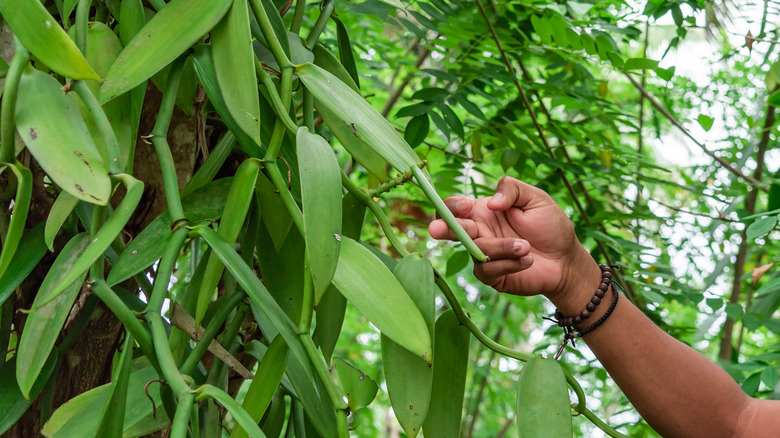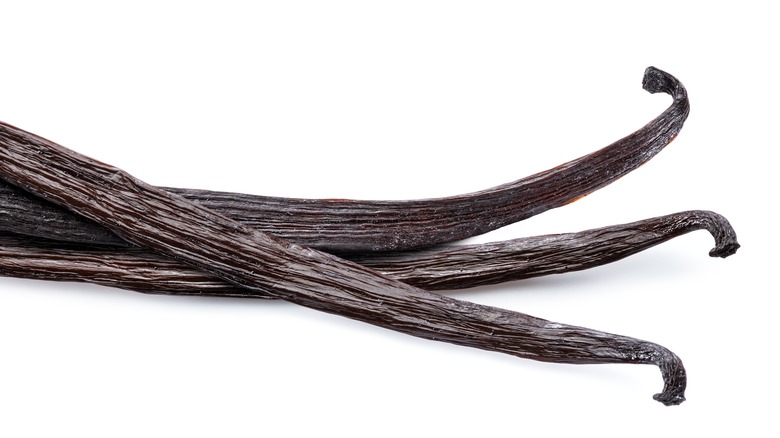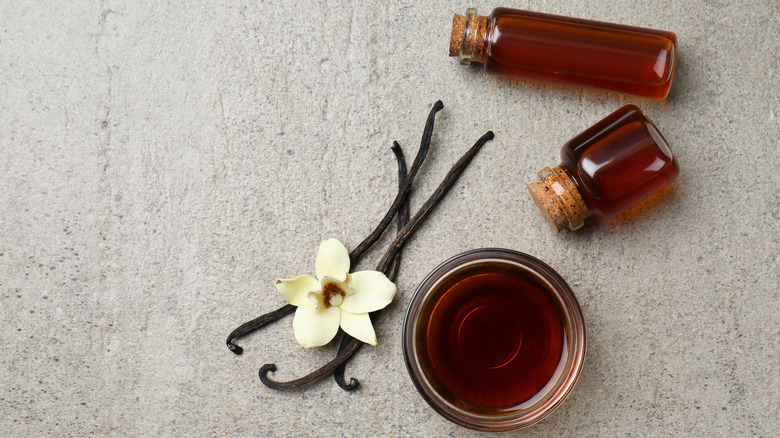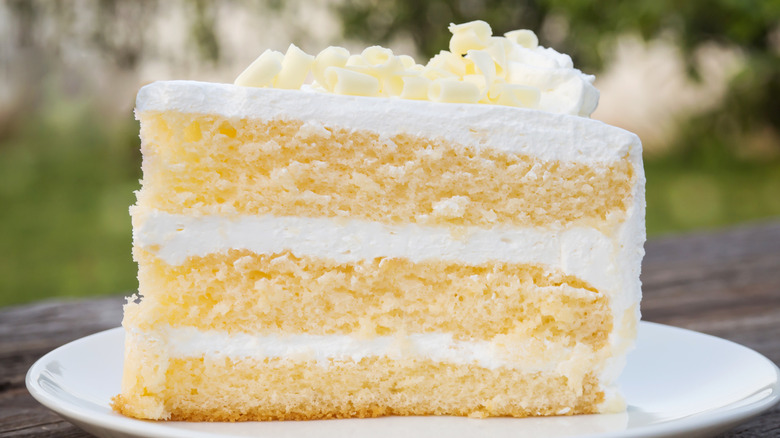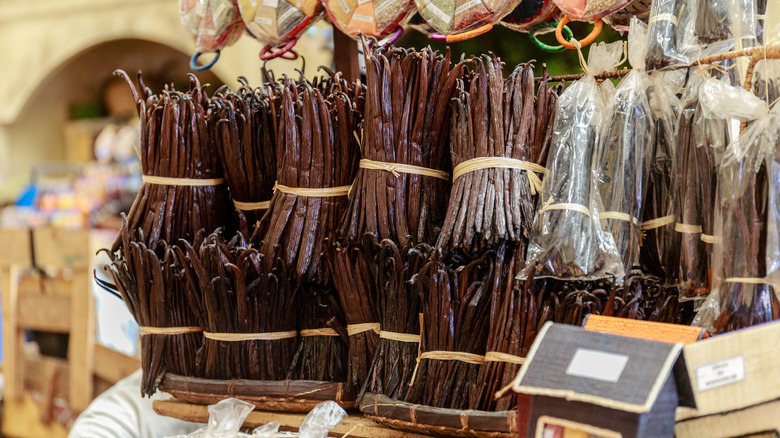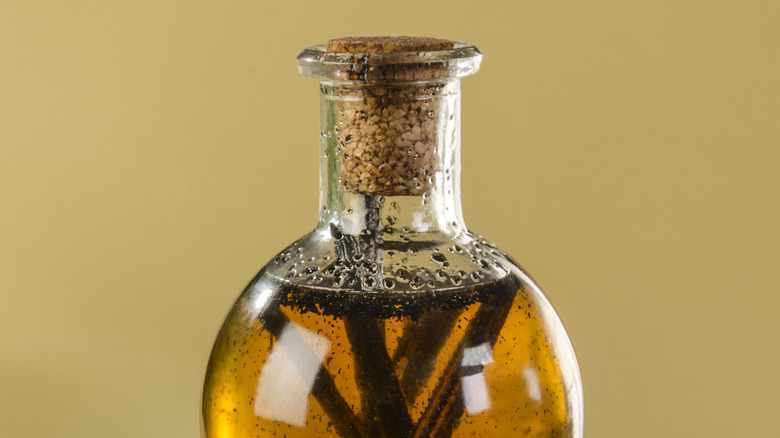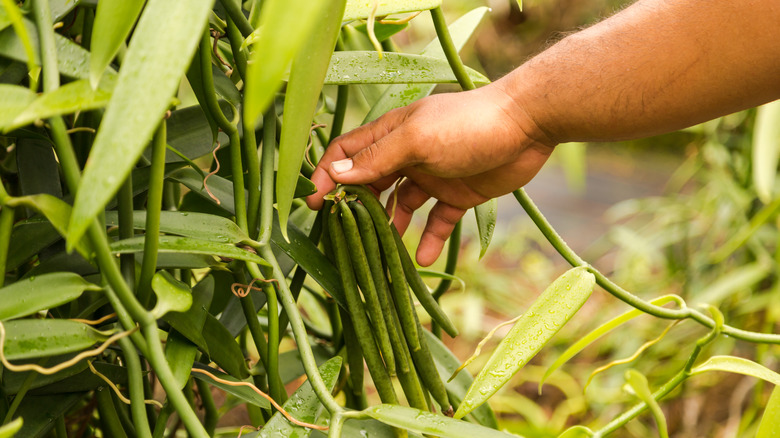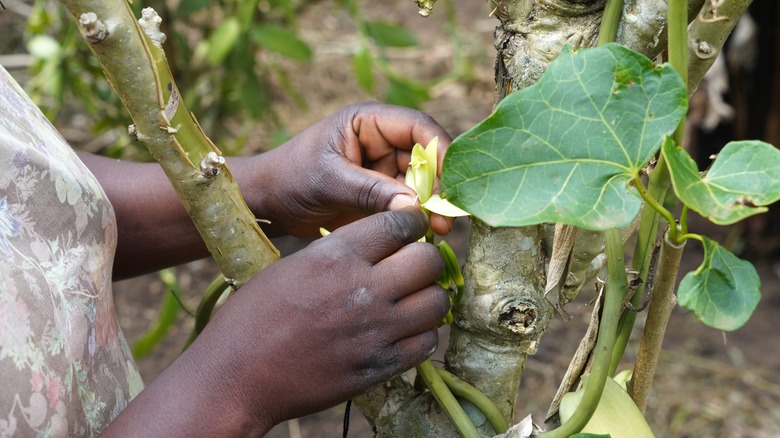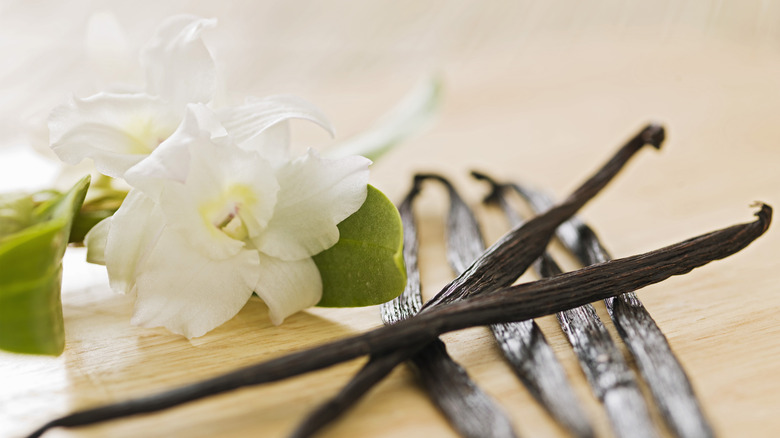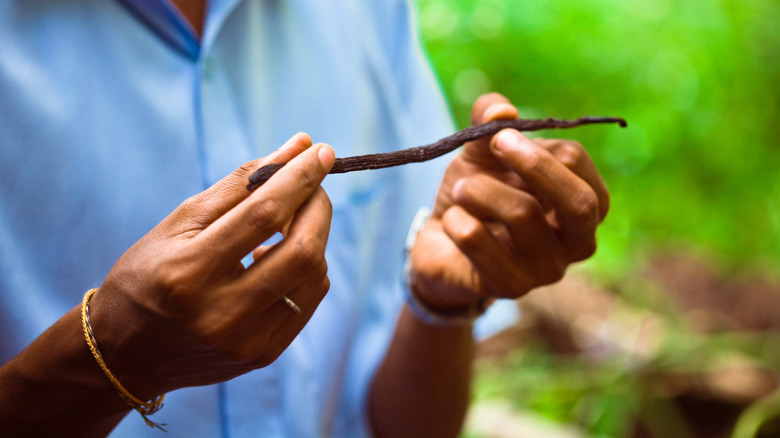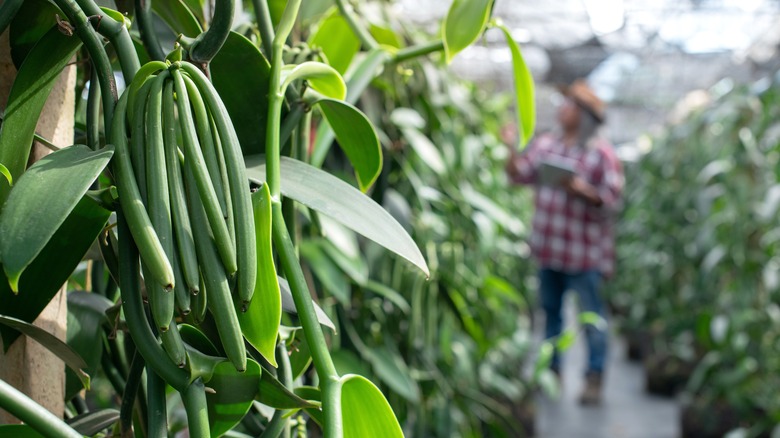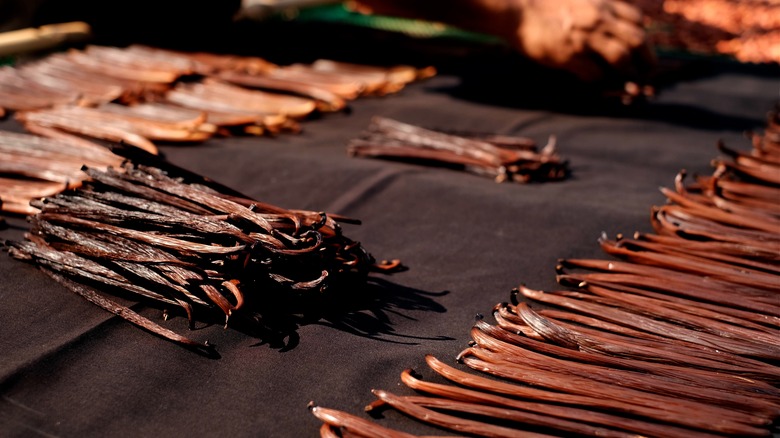A Comprehensive Guide To Every Type Of Vanilla
Enthusiastic cooks and bakers can be forgiven for wanting the best possible version of an ingredient for a recipe. After all, you're not going to go to all the trouble of learning how to brûlée things just to have the dish taste like bottom-shelf additives, right?
But, when it comes to which kind of vanilla to use for a certain recipe, choosing is not as easy as it sounds. In fact, it's not easy at all, because there are so many varying types of vanilla on the market. The beans that make the extract come in different species and are grown in different locations, making for a hodgepodge of genetics and terroir that affect flavor more than you'd think. What form you buy the extract in matters, too.
As such, it's important to understand the different types of vanilla available, from Madagascar to Tonga to imitation varieties. By the time you're done reading, you'll know what the varying kinds are, how they differ, and how to choose the right one for your future recipes.
A brief history of vanilla
Contrary to popular belief, vanilla is not a bean at all, or even a legume for that matter. Rather, it's an orchid flower native to Central and South America and the Caribbean. It was used by locals for centuries, millennia even, before being "discovered" by colonists. Indeed, the Totonacs (a people of East Mexico) were likely the first to cultivate it, prizing the plant for religious ceremonies and as a perfume.
The Aztecs later conquered the Totonacs and then taxed them in vanilla pods. Unlike the Totonacs, the Aztecs enjoyed vanilla for culinary reasons, such as putting it in chocolate beverages (always a classic combo). These cultures also believed vanilla had aphrodisiac and medicinal properties, according to a study in Seminars in Integrated Medicine.
Once Europeans arrived, the story of conquest was repeated. The flavor immediately appealed to the Europeans who tried to grow it at scale. Unfortunately, vanilla is quite specific about its needs, and it took some time to establish it around the world. Vanilla now predominantly grows in Madagascar, Mexico, and Tahiti, thriving in climates located 10 to 20 degrees on either side of the equator.
Two vanilla species reign supreme
Although there may be 140 types of vanilla that exist around the world, there are only two actual species that are cultivated for culinary use. Most of the others grow wild in small quantities close to their native ranges, never achieving the notice of the foodie world.
As for the cultivated varieties? Vanilla planifolia is the gold standard, with a scent and flavor profile familiar to most. It's the most commonly cultivated type, and you can find it around the world, from Mexico to Madagascar. When you take a forkful of vanilla cake or dig up a scoop of vanilla ice cream, the smooth and creamy richness that hits your palate is redolent of V. planifolia.
Vanilla tahitensis is the other species grown commercially, although it's actually a hybrid of the planifolia and odorata species, the latter of which is not one of the cultivated types of vanilla. Consensus is lacking about whether V. tahitensis was bred or is a happy accident of Mother Nature, occurring in the cacao-producing forests of the Maya people.
Vanilla pompona is another lovely species, with nice earthy tones, and it does have a short history of cultivation. However, farmers don't grow it today, because it's not as productive as V. planifolia, and meeting the world's insatiable appetite for this flavoring is hard enough as it is.
How is vanilla grown?
A stunning 80% of vanilla is grown in Madagascar, with the country relying on it as its primary export crop. The rest is located on large farms across the equatorial belt, where the vanilla vine grows on trees or other supports. It's an epiphyte that doesn't need soil, as the roots take nutrients and moisture from the air, and healthy plants can reach lengths of 50 to 75 feet (15 to 23 meters).
Pollination is a critical component of the cultivation process. In the Americas, the Melipona bee does the job, as it's small enough to reach the pollen, whereas the honeybee is not. In areas outside the Melipona range, such as Madagascar and Tahiti, the flowers must be pollinated by hand.
This is a fascinating and labor-intensive process in which farmers carefully open the vanilla flower, and then use a toothpick or other small tool to make contact between the male and female structures. Since each vanilla orchid only flowers once a year, and the bloom only lasts for 24 hours, pollination season is busy. This helps explain the price of vanilla.
How are vanilla beans cured?
Before vanilla beans can be used, they first have to be picked and cured. Although most people associate the beans with the blackened, shiny pods seen in the grocery store (and in every Instagram cook's flatlays), they do not come off the vine this way. Instead, the beans must undergo an intensive process to develop their signature flavor and aroma.
First, vanilla bean pods are plunged into hot water to prevent fermentation, then they undergo an alternate process known as sunning and sweating. During the day, farmers lay the beans out in the sun to heat them, then stack them at night to encourage high temperatures and water evaporation. Even so, adequate moisture levels are retained that allow for the chemical reactions that contribute to flavor. Following this step, the vanilla is dried, which can take several weeks, then packaged and left in the dark to continue curing.
This process takes months, further explaining vanilla's high prices. But wait — it's not over yet! Making the extract is yet another step in the process, adding even more time and resources.
How is vanilla extract made?
Bottling vanilla with water and alcohol is the part that extracts its flavor, hence the household name. Despite the widespread use of imitation products, pure vanilla extract is still widely available on supermarket shelves.
To earn the label "pure vanilla extract," manufacturers have to follow specific instructions. According to the Food and Drug Administration (FDA), this means "the content of ethyl alcohol is not less than 35% by volume and the content of vanilla constituent ... is not less than one unit per gallon." While vanilla extract can contain glycerin, propylene glycol, sugar (including invert sugar), dextrose, or corn syrup, this must be disclosed on the ingredients list, according to the FDA.
Making vanilla extract takes time, too. The beans must soak in alcohol for at least eight weeks to flavor, but six to 12 months is even better. If you're a curious cook interested in saving money, you can always buy the beans yourself and then make the extract with just a cup of liquor (vodka, whiskey, and rum all work) and six vanilla beans, which you can get online for $15 or so. Slit the beans and cut them shorter if necessary to fit all pieces in an 8-ounce bottle, then pour the alcohol over and leave them to soak for eight weeks to 12 months. By the end, you'll have a full 8 ounces of vanilla extract for less than $20.
What about imitation vanilla?
Humans the world over love vanilla, which at one point was more expensive by weight than silver. Today that's not the case, but vanilla's price does fluctuate rapidly, sometimes swinging by as much as 20% in a matter of weeks. We want a lot of vanilla.
Although one might assume vanilla flavoring comes entirely from vanilla plants, but that's not the case. True vanilla can only meet 1% of market demand. Yes, you read that correctly: literally 99% of vanilla flavoring comes from other sources. Most of it is from artificially produced vanillin (the main flavor compound) made in a lab. Manufacturers can also reuse spent vanilla pods to extract additional flavor using enzymes.
Imitation products are often simply labeled "vanilla essence" or "vanilla flavor," which are signs that you're dealing with an imposter. Oh, and that rumor you've heard about fake vanilla coming from a beaver's butt? While beaver glands do produce nice smells for perfume, this is almost certainly not true for baking supplies.
As for pure vanilla extract, the vast majority of the product is one species of vanilla (V. planifolia). However, it inherits different flavor characteristics from the place in which it was grown and the process used to cure the beans. Vanilla is similar to wine, with the same species producing astonishingly varied flavors by region. From Madagascar to Mexico, Tahiti to Uganda, Indonesia to India and Tonga, the following are the most common types of pure vanilla extract available today.
Madagascar vanilla
The most common vanilla of all is Madagascar, which as mentioned produces most of the world's vanilla supply. It is a fabulous region for growing vanilla, warm and humid, and perfect for not only raising the plants but curing the beans. The area produces a rich, creamy flavor in vanilla that is what you might call "classic" vanilla, and keeps most of us supplied with the extract we have in our kitchen cabinets.
Note that Madagascar and Bourbon vanilla are different, though frequently associated. Bourbon vanilla is V. planifolia, and it was named after an island (now called Réunion) in the Indian Sea rather than the liquor in which the beans are soaked, as is commonly believed. Much like Champagne can only be called such if it comes from that region in France, Bourbon vanilla can only be called that if it comes from Madagascar, Réunion, the Seychelles, Mauritius, or Comoros.
With its smooth and well-rounded vanilla flavor, Madagascar is well-suited to recipes that call for a rich vanilla taste, such as in frosting, custard, meringues, or hot chocolate. In general, if you're making something rich and creamy where vanilla is the true star, like classic vanilla pudding, a delicious cheesecake recipe, or foolproof whipped cream, stick with Madagascar vanilla. However, it also plays nicely with cardamom, a piney, peppery, floral spice hailing from southern India.
Mexican vanilla
When you think of Mexican flavorings, chances are you think of something smoky, rich, maybe a little spicy. And it turns out, that's exactly how vanilla gets updated when it's grown in Mexico. That makes Mexican vanilla a delicious choice for mixed drinks, spiced cookies, gingerbread, and more.
As with other types, Mexican vanilla refers to the region in which it is grown. The vanilla plant itself can be V. planifolia, V. tahitensis, and occasionally V. pompona, despite its lack of widespread appeal for cultivation. Because Mexico is in the plant's native range, V. pompona grows well there and so it is sometimes used to make commercial vanilla products.
The deep and woodsy flavor of Mexican vanilla has been compared to clove and nutmeg, suiting it well to desserts that use warm spices like gingerbread as well as citrus and chili powder. You can even use Mexican vanilla to amplify the flavor of tomato sauce.
Tahitian vanilla
Tahitian vanilla is a source of some confusion. You'd think that V. tahitensis would be colloquially known as Tahitian vanilla, but in actuality, a more correct way to denote this hybrid is Vanilla x tahitensis to indicate that it is a cultivar developed from a cross. This species can be grown in places other than Tahiti and is common in Hawaii and sometimes Mexico as well, both of which share a climate with Tahiti and other parts of French Polynesia.
As mentioned, Tahitian vanilla is known for being delightfully floral. Its light flavor complements fruity and citrus-laden dishes and is also used in perfume. Tahitian vanilla tends to be at the top of the pack, price-wise, because its farmers use a more laborious curing method. Its small annual yield also adds to the increase in price, as the French Polynesian island grows only 1 percent of the world's vanilla crop. It's darn delicious, though.
Opting for fruit, like mixed berry scones? Your recipe will appreciate the floral notes lent by Tahitian vanilla. In general, it's a great flavor for refrigerated and frozen treats, where its flowery essences hold up even with the flavor-diminishing power of cold temps. If you're making milkshakes, smoothies, or Baked Alaska, go Tahitian.
Ugandan vanilla
The Ugandan vanilla outfit is quite small compared to the rest of the world, but it is unique in that it has an appropriate climate for vanilla but has not one but two dry seasons a year. That means it can produce a larger vanilla crop. The flavor of these beans is said to be like milk chocolate and dried fruit, with a high vanillin content that makes for very rich flavors.
Vanilla extract from Uganda is relatively rare, so it's quite expensive. The pure version is probably out of reach for most home cooks at upwards of a dollar a bean, but you can find a somewhat more bastardized version online that also includes cane sugar. If you're one who likes to experiment, you could try that first and then see if your money will be well spent on some actual Brad Pitt-level Ugandan beans. Who knows, you may discover the money is worth it.
Ugandan vanilla pairs well with strong flavors such as chocolate, caramel, and citrus. Consider giving your favorite brownie, caramel sauce, and lemon bar recipes an upscale twist with Ugandan vanilla extract or beans.
Indonesian vanilla
Another of the most common types of vanilla is Indonesian. Like their Madagascan counterparts, these mostly V. planifolia beans are rich and creamy, with top-notch pure vanilla flavor. However, Indonesian vanilla is a little more complex. The area lends vanilla woodsy, smoky, and chocolatey scents and flavors. Fruity and figgy notes also come forward on the palate when you use vanilla products from India.
Even more appealingly, vanilla from this area is said to hold up to baking without losing its flavor, like some of the other extracts do. If you buy Indonesian vanilla, feel free to experiment with how much you need in a recipe. You may need less than it calls for, or you may find that using the same amounts gives you a much larger bang for your buck, in which case it might be worth spending the money on beans whose prices compare to Ugandan.
Chocolate calls for a deep flavor, such as that provided by Indonesian vanilla. Use it for everything cacao, from classic brownies and chocolate shakes to hot chocolate and mousse.
Indian vanilla
Indian vanilla is described as rich, full, and chocolatey, with a creamy flavor that some claim is superior to the Madagascar variety. According to sources on the internet, India is ramping up its vanilla production and becoming a bigger contender, so you may see more products that hail from this country soon. Like its cousins in Indonesia, Uganda, and Tahiti, however, these vanilla beans do tend to be quite pricey as they're still an up-and-coming product.
Indian beans are naturally very sweet, so they're perfect for recipes that call for a lot of vanilla flavor. They have a woodsy tinge and smell very strongly of vanillin, so they stand out well in any recipe where vanilla is the "hero flavor," as Paul Hollywood and Prue Leith would say. Because of that, it shines in confections such as vanilla sugar (for rolling sugar cookies in), vanilla frosting, or vanilla custard.
You could also try updating your traditional vanilla custard to fruit custard, a classic Indian dessert that includes fruit and nuts. It's considered party or special occasion food there, and often features bananas, mangos, apples, or pomegranates. Note: Avoid sour fruits, like citrus and pineapple, that might bury the flavor of the vanilla.
Tonga vanilla
Tonga is an island country in the southwestern Pacific Ocean, comprised of about 170 individual land masses, only a small percentage of which are inhabited. The volcanic island chain has rich, fertile soil, leading to beans with an extremely bold flavor. For that reason, they're often favored by chocolatiers or other dessert-makers who want the vanilla to come through even when it's up against the strongest flavors.
Tongan vanilla pairs well with strong berry flavors, alcohol-laced desserts, citrus, or spicy concoctions à la chocolate with chilis or other Mexican-style treats. Think marionberry cheesecake, boozy milkshakes, or homemade ice cream (which home cooks can make even without a machine). It's also lovely for making vanilla sugar.
Tonga vanilla beans are so expensive that to buy them in bulk, you must request a quote from the supplier. It's probably safe to say that the average home cook won't be using them any time soon, though you can sometimes find them more affordably in samplers on the internet. Be fast, though, as they quickly go out of stock.
Beans, powder, and paste: Other types of vanilla
You may also come across vanilla beans, vanilla powder, and vanilla paste in your search for the ultimate ingredient, so it's helpful to know when to use each of these as well. Vanilla beans are the purest form of the flavor, sweet all on their own, and they give you that delightful black speckle that many associate with old-fashioned ice cream. Use vanilla beans when you're making rich drinks such as steamed milk or hot chocolate, where the desired result is super creamy. You can also slit vanilla pods open and scrape out the seeds with the tip of a knife as another perfect addition to your homemade vanilla ice cream.
Use vanilla bean paste in creamy recipes such as frosting, custard, or ice cream, where the format makes flavoring with vanilla super easy. Vanilla powder is really just the paste before the addition of water, but it's unique in that you can put it in a recipe while also using it on its own. Dust it over a vanilla latte or sprinkle it on cookies for a delightful zing. Just make sure to buy the kind that has no added sugar so you can control the sweetness.
